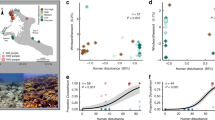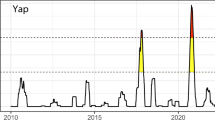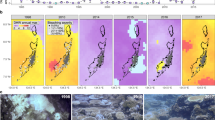Abstract
Hoegh-Guldberg et al. suggest that corals that were transplanted downwards died more frequently than those transplanted upwards because they were deprived of critical sunlight energy at depth. My argument went a step further by explaining why this energy is so critical for these transplanted colonies.
Similar content being viewed by others
Baker replies
Because corals that were transplanted downwards did not bleach in response to reduced irradiance, they failed to exchange their 'high-light' algal symbionts for the more suitable 'low-light' algae that were already found in the deep-water colonies at this site (and/or at other sites nearby). As a result, they contained inappropriate algae for their new environment, which led to chronic stress and eventual mortality.
In contrast, corals that were transplanted upwards experienced severe bleaching as a result of increased irradiance. Consequently, suboptimal low-light algae were removed, allowing high-light algae to become dominant in the newly vacant hosts. Such corals survived well as a result, despite their initial bleaching. This explanation is particularly powerful because it unifies coral bleaching, symbiont change and host mortality.
Hoegh-Guldberg et al. suggest that my findings fail to support the ABH because they do not provide evidence of 'new' symbionts in transplanted corals. The ABH is not limited to this constraint. Regardless of the origin of replacement symbionts (which, as I pointed out, may "colonize" and/or "proliferate inside" hosts) or the proximate environmental causes of bleaching (for example, light or temperature), if bleached reef corals change the composition of their symbiont communities faster than unbleached corals, and if more rapid symbiont change proves beneficial, then bleaching has adaptive value. Even if adult colonies are unable to form symbioses with unusual or new algae (which is unlikely, given the recent discovery of some scleractinian coral colonies containing symbionts that are usually found in foraminifera1), cryptic populations of diverse symbionts may still occur at low abundance in many coral hosts2.
There is no field evidence that symbiont genotypes change after bleaching events because the necessary molecular investigations have not yet been undertaken. Despite this, one of the best available long-term data sets on mass coral bleaching and mortality reveals that far fewer corals in the far-eastern Pacific Ocean died after the 1997–98 El Niño event (0–26%) than after the 1982–83 El Niño event (52–97%; ref. 3), even though the magnitude and duration of sea-surface temperature anomalies in the region in 1997–98 exceeded those of 1982–83 (ref. 4). These observations indicate that surviving reef corals may be more resistant to recurrent thermal stress through having experienced earlier episodes of severe bleaching and mortality, as predicted by models of symbiont change5.
Furthermore, field experiments with bleached corals6 and laboratory studies of model invertebrate–algal symbioses7 support some of the assumptions of the ABH. We should not mistake an absence of evidence for evidence of absence, and instead need to document worldwide patterns of coral–algal associations and their response to mass-bleaching events. The real question is not whether coral–algal associations can adapt by recombining, but rather how, and over what timescales, they do so.
Although episodes of mass coral bleaching and mortality will occur in the future, my findings suggest that they may not recur with the frequency and severity predicted by some studies8. This should stimulate efforts to protect the remaining three- quarters of the world's coral-reef ecosystems9 by reducing the compounding effects of anthropogenic factors that are still under our influence.
References
Rodriguez-Lanetty, M., Cha, H. R. & Song, J. I. Proc. 9th Int. Coral Reef Symp. (in the press).
Goulet, T. L. & Coffroth, M. A. Proc. 8th Int. Coral Reef Symp. 2, 1331–1334 (1997).
Glynn, P. W., Maté, J. L., Baker, A. C. & Calderón, M. O. Bull. Mar. Sci. 69, 79–109 (2001).
Enfield, D. B. Bull. Mar. Sci. 69, 7–25 (2001).
Ware, J. R., Fautin, D. G. & Buddemeier, R. W. Ecol. Model. 84, 199–214 (1996).
Toller, W. W., Rowan, R. & Knowlton, N. Biol. Bull. Mar. Biol. Lab. Woods Hole 201, 360–373 (2001).
Kinzie, R. A., Takayama, M., Santos, S. R. & Coffroth, M. A. Biol. Bull. Mar. Biol. Lab. Woods Hole 200, 51–58 (2001).
Hoegh-Guldberg, O. Mar. Freshwat. Res. 50, 839–866 (1999).
Wilkinson, C. (ed.) Status of Coral Reefs of the World: 2000 (Austral. Inst. Mar. Sci., Townsville, Queensland, 2000).
Author information
Authors and Affiliations
Corresponding author
Rights and permissions
About this article
Cite this article
Baker, A. Is coral bleaching really adaptive?. Nature 415, 602 (2002). https://doi.org/10.1038/415602a
Issue Date:
DOI: https://doi.org/10.1038/415602a
This article is cited by
-
Acquisition of symbiotic dinoflagellates (Symbiodinium) by juveniles of the coral Acropora longicyathus
Coral Reefs (2008)
-
Len Muscatine (1932–2007) and his contributions to the understanding of algal-invertebrate endosymbiosis
Coral Reefs (2007)
-
Adaptive bleaching: a general phenomenon
Hydrobiologia (2004)
Comments
By submitting a comment you agree to abide by our Terms and Community Guidelines. If you find something abusive or that does not comply with our terms or guidelines please flag it as inappropriate.



